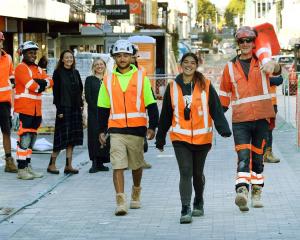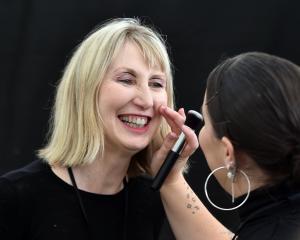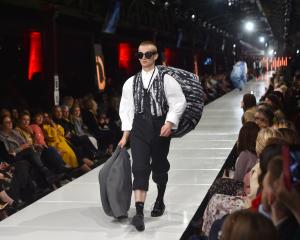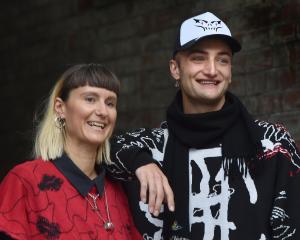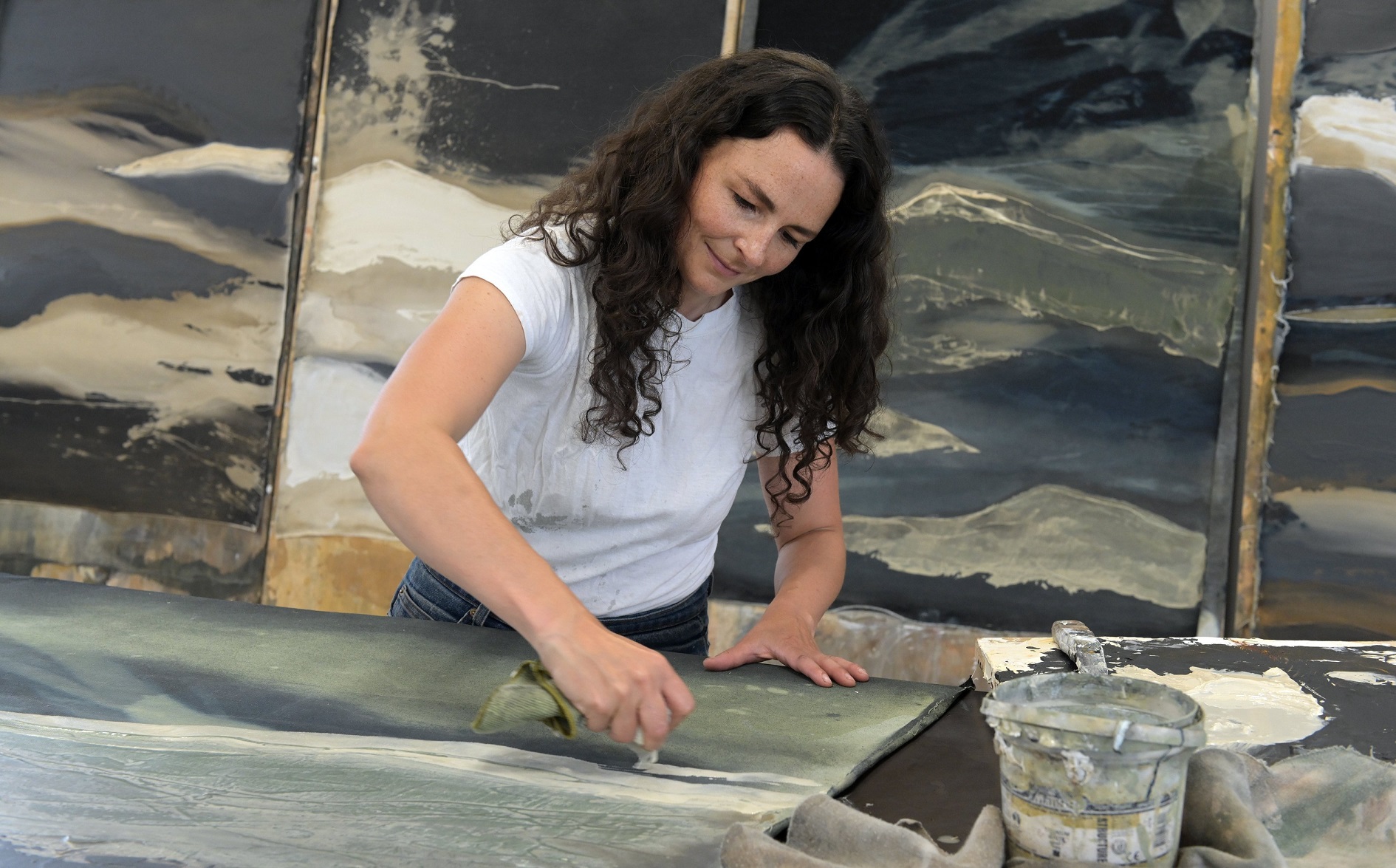
Just a few years ago Meg Gallagher was entrenched in Sydney’s fashion world, relishing the challenge of being the denim whizz kid.
"It was my dream job. I got the job I was desperate for when I was studying fashion," she says.
Yet she had this magnetic pull to come back to Otago, something she never thought would happen 20 years ago.
"By the time I got my dream job, my passion and focus was on the art and painting. I was a different person."
She started painting in Sydney four years ago, after she had her son, discovering "never-ending" inspiration from the world around her.
"It escalated so quickly because everything is so easy to buy online at the moment. Everyone loved my connection to New Zealand and Australian landscapes."
Personally, it also resonated, as it was her work, whereas in fashion she was bringing to life someone else’s vision.
"I loved the creative part of it, but it was always their kind of thing. When I was creating my art, it was that calmness and stillness of me being able to do things at my own pace."
Gallagher began to question why she was still "hussling" in Sydney. She knew if she returned to Dunedin she could make art her primary focus.
"Also slow down a bit, not focus on quick sales. I could choose the things I wanted to do."
So she made the decision and moved back to Dunedin a year ago. She did have a few qualms about whether her art practice would continue to be successful.
"But it’s been beyond what I could expect. It’s been so good. I’ve got a never-ending bucket of inspiration here. I feel so connected to myself and this place, it’s made me like, so much more considered and thoughtful as an artist."
Coming back was made easier by finding studio space while she was still stuck in Sydney during Covid. Her brother, an illustrator, was able to check it out and give it his tick of approval although there were concerns about the size and cost of the space.
Its attributes of being light and airy and in a great location won them over. They went ahead and hired the space with the aim of getting other creatives to join them and share it.
"I was able to hit the ground running and we were able to find a great mix of people. You get all the benefit of having work friends, but without having to talk about work . . . as we are doing our own thing. It’s so nice."
She has also discovered Dunedin is a different place to the one she grew up in. The former Otago Girls’ High pupil went on to study philosophy at the University of Otago for a year.
"As much as I liked it, I was just drawing the whole time."
Then there was the choice to go to fashion school or art school. Otago Polytechnic’s fashion school won out because of its strength in practical skills and the opportunity to do an exchange to Milan, Italy.

She was named as "One to Watch" by Vogue Italia and awarded the scholarship to study at Milan’s Istituto Europeo di Design.
It gave her the boost to move to Wellington.
"I felt like I had to spread my wings and go. I didn’t feel like there was enough stuff here for me to grab on to."
However, now she has discovered Dunedin’s wonderful vibe of creatives doing new and interesting things.
"There is a nice support circle here. If you knew me when I was 20 working in fashion, I was not Dunedin’s biggest advocate. Now I’m like Dunedin’s number one tourism advocate."
She is able to quickly put her friends’ concerns about how she is going in the deep south to rest.
"It’s amazing. I must be a lot older. The quality of life I can have and the ease of everything makes me feel so creatively free."
Coming from a fashion background she initially thought she would not be taken seriously as an artist.
"It’s funny, it’s my thing. I came to working on denim because I started doing jeans and I worked out how to make them different colours and then I started working for a very experimental jean company that allowed me to tie-dye them and stuff."
She started out in Sydney working in womenswear design roles for designers such as Collette Dinnigan before ending up at Ksubi, an experimental denim company.
"They had this cool grungy vibe I could connect with, almost similar to NomD and Zambezi, I got it."
Having that knowledge from polytech about textiles meant she was not afraid to experiment.
"I had no idea that was my thing. At polytech I was definitely known for not being great at patterns or sewing or all the really finicky things, but I was really experimental with textiles and shape, the colours and bigger picture."
At Ksubi she really got to know what could be done with denim, how it could be changed, how varied it was.
"You have to stop me on the denim nerd talk. Once I got on to it, I absolutely loved it."
She became their denim designer before leaving to go to Camilla and Mark who wanted to introduce a denim range.
"It’s quite rare [occurrence] for someone who just works in denim."
General Pants Group, who own Ksubi and other brands, then asked her to be design director to revive their denim collections. She worked for it for eight years.
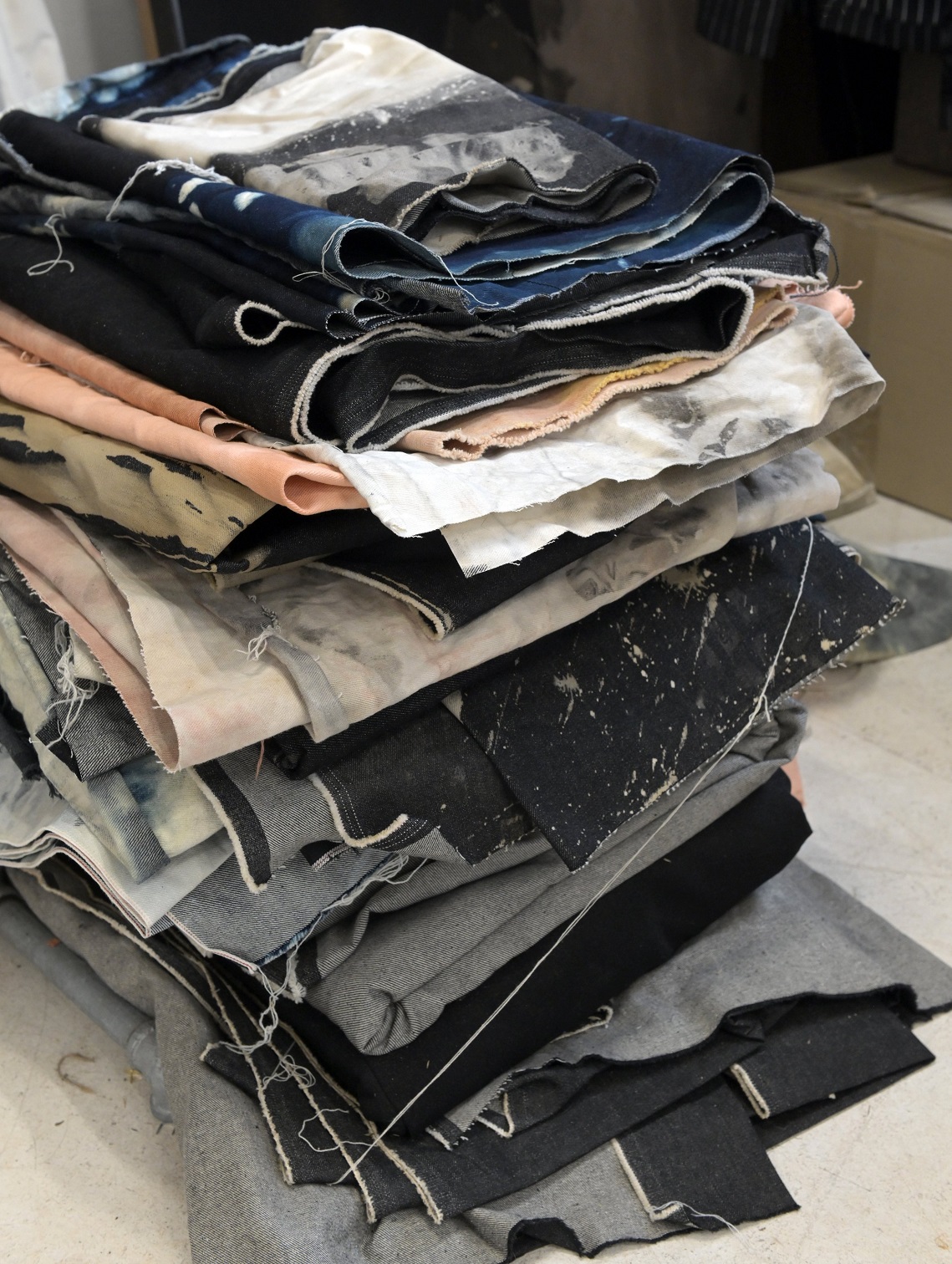
The company also emphasised the importance of travel, so Gallagher got to travel to the factories where the denim is produced. She travelled to Japan to hunt out vintage denim for inspiration and then to Hong Kong and Turkey to work with the factories producing her designs.
"Not every designer gets to travel and go to the factories, but because my job was so textiles-based it was really important for me to go and I built these really great relationships."
When she started painting, she discovered a roll of denim at home leftover from a project, and thought she would try using it as a canvas.
"I was like ‘oh this works’. So I started playing around with that."
Then on one of her trips to Hong Kong she asked if they had any leftover denim she could have. It turned out having 5m leftover from a run was nothing to them. They were happy to put aside any uncut remnants for her.
"I started getting this beautiful odd mix of denim arrive occasionally and I started to play around with what was given to me."
Her Australian home had a space under a balcony where she could happily experiment without worries about getting dye, bleach or paint everywhere.
"It was a wonderful accidental space to use."
To make her works she starts off with raw pieces of denim which she hangs outside on washing lines or rocks and pours bleach on it to strip the colour away. Then she mixes up dyes and pours, dips, strokes them on to the material and leaves it there, sometimes for days.
"I let them soak up dyes in different areas. Then I eventually place it in the washing machine and bring it into the studio. When I’ve got these hectic, textural pieces of cloth I lay them out and work out which ones are speaking to me."
At that stage she is not trying to make a particular composition. She cuts it into the size she wants, stretches it on to huge pieces of ply board and staples it.
"I came up with this technique in my outdoor studio in Sydney because I didn’t have walls."
Then she creates a mood board of images she is "into" to have a reference of colours and shapes she likes.
Due to her fashion background, using Photoshop is second nature so she uses that to block out shapes and colours to help her avoid the parts of the textile she does not want to cover.
"I do a tiny plan. I don’t sweat over it. I stick it next to the painting. The painting never turns out like it. I then start layering on thick layers of acrylic. I use palette knives, not brushes. I only use a brush to sign my name."
Between all the steps a lot of drying time is required — sometimes up to three days in winter.
"I think it’s kind of healthy, it forces me to step away from it."
At the start of the process, she works on the pieces upright, but then she lies them on the floor for the final paint layer.
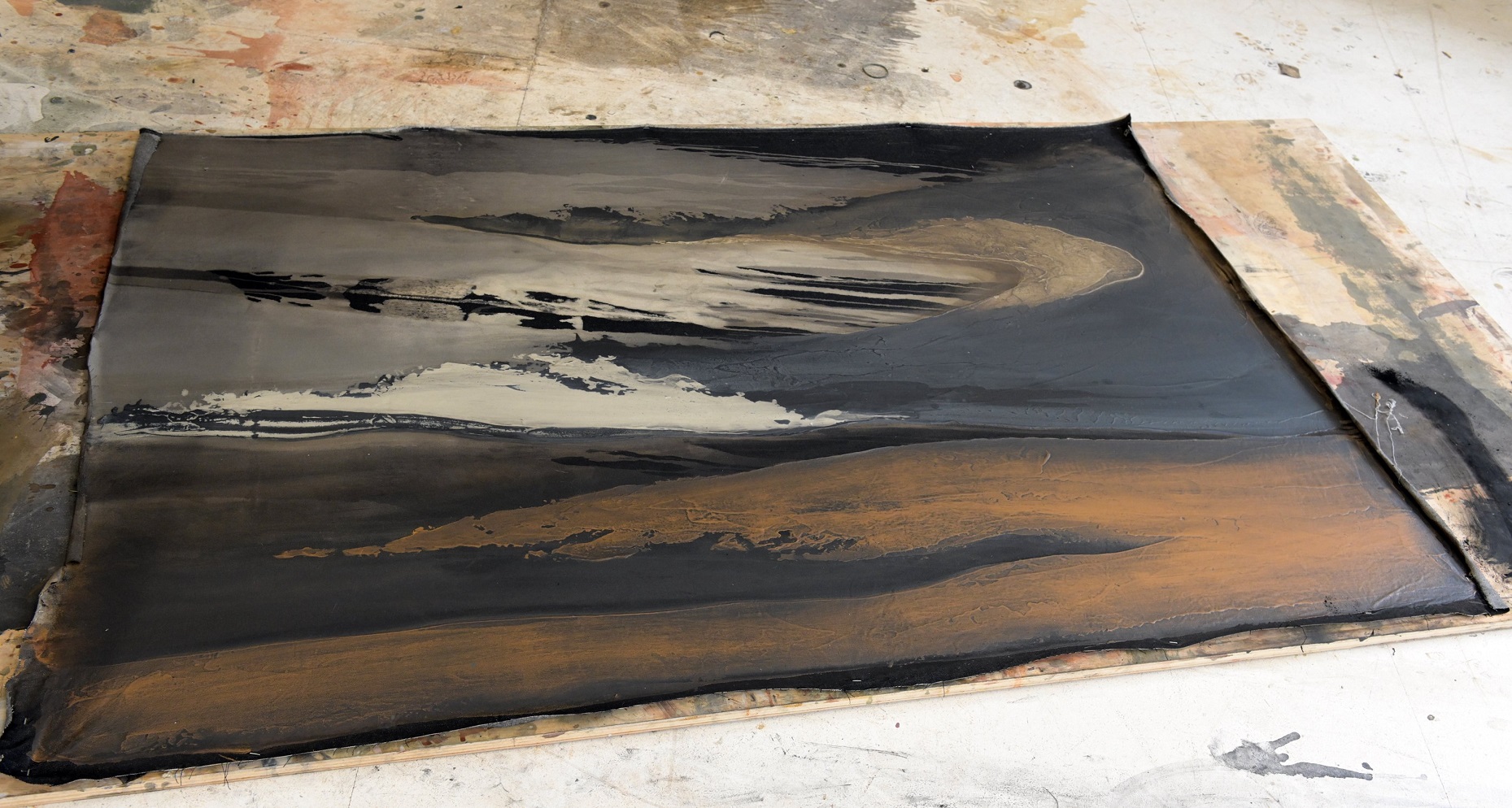
"I was prepared to say goodbye to all of that stuff, but things that come up I try to squeeze in, it feels natural to do and they’re really supportive of my art too."
She has realised all her visual references and inspiration come from her experience in textiles and fashion, even her use of colour.
"Even though I do landscapes, the colours I use are what I see in a lot of in interior architecture or fashion.
"I think it might be why people are drawn to them in a way. It’s not just grass is green and the sky is blue. I try to never do that with my stuff. The ground can be pink, the sky can be brown."
The past couple of months she has been working on material for a show in Sydney and one here in Dunedin at Olga to tie with iD Dunedin Fashion Week — she is a former iD International Emerging Designer Award finalist.
"I thought it is a beautiful lifetime loop of coming back. In a way it inspired all the pieces I’m doing for it."
Gallagher even got in the car for a tour around Otago Harbour for inspiration, driving to Aramoana and around to Portobello stopping along the way to take photos. Her mother lives at Broad Bay and her father at Port Chalmers so the journey from one side of the harbour to the other is etched in her memory.
"I’ve got such a nostalgic memory of driving around the harbour and seeing all those shapes and landscapes etched on the harbour. Coming back, I see Dunedin in this whole new rose-tinted glasses way. I had all this inspiration already there in my mind."
The result is a series of paintings that have some literal features, but are more about appreciating the light and dark side of Dunedin, maybe as a way to apologise for being so dismissive of the city when she was younger, she says.
"It has this really nice moody gothic thing to it as well as this positive side to it. I wanted to paint Dunedin in this magical way without making fantasy paintings."
Looking back over the past couple of years, Gallagher says it has been this "bizarre organic journey".
"If you told me even five years ago this is where I’d be, I’d say ‘what?’. I was really into this hard-core fashion job and had all these staff I was responsible for, but it’s so interesting how easy it was to give it up."
Gallagher just fell in love with art.
"I felt this is what I was meant to be doing."
The Covid situation meant she had a taste of what it would be like to slow down and she had the time to reassess her priorities. The ease of working remotely also highlighted she could work from anywhere.
"What’s the difference of me being in Dunedin or living in Sydney. The world doesn’t seem so inaccessible from here. Nobody cares where I am.
"If anything, they kind of love that I’ve decided to hibernate in Dunedin and paint. It makes it unique and authentic."
TO SEE
Meg Gallagher – Recent Works, opening event, Olga Art Gallery, Dunedin, April 1, 3pm-8pm



